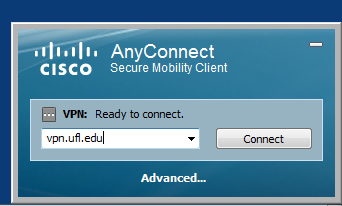IMPORTANT: Your office computer must be turned on or you can’t connect remotely.

- Cisco Anyconnect keeps disconnecting and reconnecting after 1 minute or so. Hi Guys, Hopefully someone can help me, we are having numerous users (not all) having an issue whereby when they connect to VPN using Cisco Any-connect (Version 4.3.04030) it keeps dropping the connecting after 1 minute or so maybe even 1 minute 10 seconds.
- Setting up the UF VPN If working remotely, you will likely need to connect to a VPN to access most of your college or university resources. To set up the UF VPN, you will first need the Cisco AnyConnect Secure Mobility Client. 1) Download and install the client for your device. If installing the Windows client, you only need the first install.
- Cisco AnyConnect Secure Mobility Client empowers remote workers with frictionless, highly secure access to the enterprise network from any device, at any time, in any location while protecting the organization.
Cisco Anyconnect Uf Download
- Once the Remote Desktop Connection has been activated on your office computer, restart your system for the changes to take effect. If the connection as not been activated, please submit a Help Request to turn on this option for your office computer.
- When off-campus, a VPN connection is required to access to your office computer via Remote Desktop
To download the Cisco VPN Client to your home computer, please click on the link below. You will need to log on with your GatorLink username and password:
https://net-services.ufl.edu/provided-services/vpn/clients/
We recommend you append /campus to your VPN logon Username (i.e., username@ufl.edu/campus).
Once you login and connect, the VPN Client is virtually placing your home computer on the campus network. This is needed to allow you to connect to your work computer. - Use your PC Computer Name/IP Address as provided to you by a TSS employee.
- There are two ways to remotely access your office computer:
- Use the preconfigured Remote Desktop shortcut attached to the email you received when your RDP was set up (ex: TSS-FA-352.rdp), or
- Manually enter the connection settings
Assuming the computer you are using is running Windows 10:- Click on the Start button >> Scroll down the Programs list to Windows Accessories >> Remote Desktop Connection.
- Enter the provided computer IP as the Computer (that is your office computer’s full computer name).
- Click on 'Show Options' in the lower left hand corner and enter your username as username@ad.ufl.edu or ufadusername.
- Click on Save and then click on the Connect button.
When you are done working remotely you can click your Start button and either Logoff or Disconnect. Disconnecting will leave your office computer in the state when you disconnected (open programs and files will be left active, essentially like walking away from your computer and letting it lock, not logged off).
Due to HIPAA requirements and HSC Security Policies, communications between your home computer and the college network must be encrypted as they may contain PHI, passwords, or other sensitive data. A virtual Private Network or VPN can secure all of the traffic between your remote computer and the UF network.
The VPN client uses your myUFL (Gatorlink) username and password to authenticate you. It then creates a secure channel between your remote computer and the UF network, and routes all traffic to and from UF through that channel.
HSC VPN

Jan 15, 2021 This Site Has Moved. NS is ICT now and moved to change your bookmarks.
The preferred VPN to use for Health Science Center business is the HSC VPN. This VPN can install from your web browser. Macs, Windows, and Linux are all supported. Just point your web browser at https://net-services.ufl.edu/provided-services/vpn/clients/ and install the appropriate client for your OS (PC, Mac, or Linux).
Cisco Anyconnect Uf Student
When you launch the Cisco AnyConnect Secure Mobility Client for the first time, enter “vpn.health.ufl.edu” in the “connect to” box.
Cisco Anyconnect Download
Further information and troubleshooting: https://connect.ufl.edu/it/wiki/Pages/glvpn-anyconnect-install.aspx
